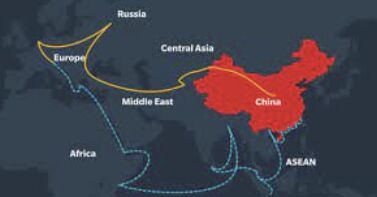China's Belt and Road Initiative Boosts Influence in Strategically Important Bangladesh, Challenging US and India
China's Belt and Road Initiative has allowed it to gain influence in strategically important Bangladesh, challenging the US and India's influence. China's increased investment and soft power tactics have solidified its position as Bangladesh's largest development partner, creating a dilemma for the country as it navigates between different powers. The competition between China and the US in the region, along with Bangladesh's geographic location and geopolitical dynamics, make it an important arena for global geopolitics.
China has been utilizing its Belt and Road Initiative (BRI) to gain influence in Bangladesh, a strategically important country that connects South Asia and Southeast Asia. According to researchers at AidData, China has been using its soft power approach to compete with the US and India for influence in Bangladesh, which both also consider to be a key player in the region. In a recent report, AidData highlighted how China has been leveraging its soft power to reshape the international order. The report revealed that China's strategic efforts in Bangladesh during the early BRI stage involved subtle media sentiment gains, giving it an advantage over the US.
However, the real game-changer came in the later BRI stage when China significantly increased its aid and credit commitments to Bangladesh. Between 2018 and 2021, China's average annual Official Development Assistance and Other Official Flows commitments to Bangladesh skyrocketed from $994 million to an astonishing $3.4 billion. This influx of Chinese investment coincided with a period of political stability in Bangladesh, which allowed China to solidify its influence in the country. Before the BRI era, China was not a major lender to Bangladesh.
However, during the BRI era, China issued grant and loan commitments worth $17.5 billion, making it Bangladesh's largest development partner. Bangladesh quickly emerged as one of China's top 20 aid and credit recipients in the developing world and the 7th largest recipient in Asia. This power struggle between China, the US, and India has created a dilemma for Bangladesh, as its turn towards authoritarianism clashes with the interests of both China and the Quad (India, the US, Japan, and Australia). China has warned against Bangladesh's potential participation in the Quad, emphasizing the potential harm to Sino-Bangla relations.
However, the Quad's pursuit of a regional economic partnership with Bangladesh has further complicated matters. In response, China has promised increased development opportunities to counter the Quad's influence. China has forged strong ties with the government of Prime Minister Sheikh Hasina in Bangladesh during the BRI era. The AidData study shows that China made significant gains in public opinion and media sentiment since 2014, with approval ratings for the Chinese government increasing during Hasina's terms in office. China even briefly surpassed the US in terms of approval ratings in Bangladesh after Donald Trump came to power.
The media sentiment about China was also more positive during Hasina's term compared to the US. However, media sentiment declined during the late BRI period due to some setbacks encountered by the BRI in Bangladesh. Nonetheless, China has greatly benefited from its strategic partnership with Hasina's government, as its development finance commitments rose dramatically. Bangladesh remains a key arena for the competition between the US and China, given its strategic location and evolving geopolitical dynamics.
The intensifying rivalry between the two powers in the South China Sea and India's growing influence contribute to Bangladesh's significance in global geopolitics. For Bangladesh, this competition presents an opportunity for economic growth and diversification beyond textiles. China's planned rail link through Myanmar offers prospects for deeper economic ties and job creation. From the US perspective, strong trade relations with Bangladesh and its alliance with India offer opportunities to establish influence in the country. However, the US finds itself in a tricky position due to democratic backsliding in Bangladesh and concerns about authoritarian trends. While Washington may feel compelled to condemn actions that could push Bangladesh towards further authoritarianism, it cannot ignore the expanding influence of China in South and Southeast Asia.




